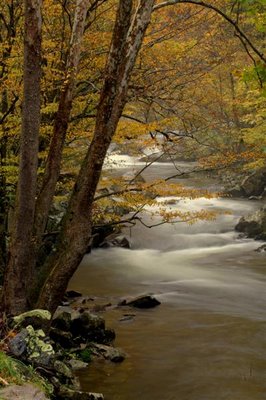 I have always loved those images of mountain streams where the water is flowing over rocks and has a cotton candy effect, but living in southern Louisiana I don't see many of these photographic opportunities. So needless to say getting a few stream shots was high on my list of photographic subject while in The Great Smokey Mountains National Park.
I have always loved those images of mountain streams where the water is flowing over rocks and has a cotton candy effect, but living in southern Louisiana I don't see many of these photographic opportunities. So needless to say getting a few stream shots was high on my list of photographic subject while in The Great Smokey Mountains National Park.After getting settled in our cabin and getting the sunrise from the top of Clingman's Dome out of my system, I set out for an afternoon of stream photography. I picked an overcast afternoon that quickly turned into a rainy overcast afternoon. As soon as I left the Cabin it started to rain and didn't stop until I returned. I considered waiting, but had already left the family napping in the cabin and didn't want to miss the opportunity to concentrate on photography for an afternoon.
There are a couple of techniques that will help when out photographing moving water that allow an enormous amount of creativity and experimentation. First of all pick a day with overcast sky or early/late lighting. This lower light level will allow you to use slower shutter speeds (up to several seconds). The softer light also provides less contrast and allows the camera's sensor (or Film) to record the full dynamic range of the scene. When I set-up at a location I like to start with a wide angle lens and look for foreground elements to lead the viewer's eye into the scene. I will usually follow with a medium telephoto lens (17-200 mm is a great choice) to isolate elements of the scene and selectively compose smaller cascades. You will want to close down the aperture of the lens to a smaller setting (say f-22 or smaller) allowing for a slower shutter speed to expose properly. In the images I have posted the shutter speed was between 2-4 secs. With shutter speeds this slow you MUST have the camera on a tripod or resting on a stable object of some kind, there is no way you can hand-hold a camera still for more than a fraction of a second.

The rule of thumb is to use a tripod if the shutter speed is slower than the reciprocal of the focal length. as an example if you are shooting at 100 mm then you can hand-hold up to 1/125 sec shutter speed. Of course the newer Image Stabilizing systems allow hand-holding to a couple of stops slower, but this still only gets you to 1/30 sec.
The other advantage of using a tripod is that it slows you down, giving you time to refine the composition, level the camera, bracket exposures, etc, etc.....
I find that using a Polarizing filter not only reduces the light entering the lens (allowing for even slower shutter speeds), but it removes the glare from rocks and leaves creating more saturation and color depth. Another filter that can help if the light levels are too high for slower shutter speeds is a Neutral density filter, this is a neutral gray filter that does not change the color of the image, but lowers the light level entering the lens.
Finally, I shot several compositions and found that looking upstream produces the most pleasing images.
Go out and take some pictures,
Thomas Even
Please post a comment and let me know what you think.







